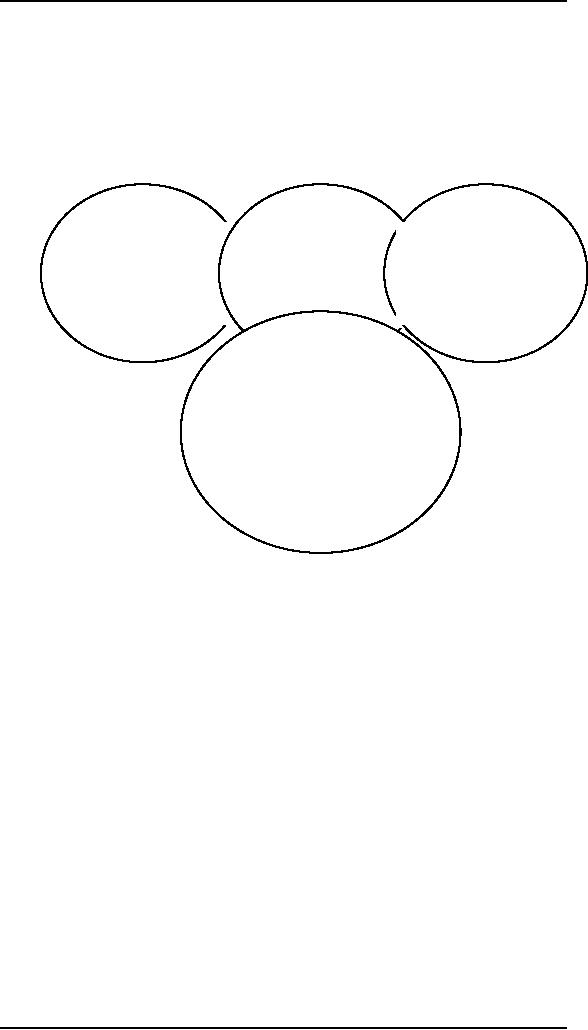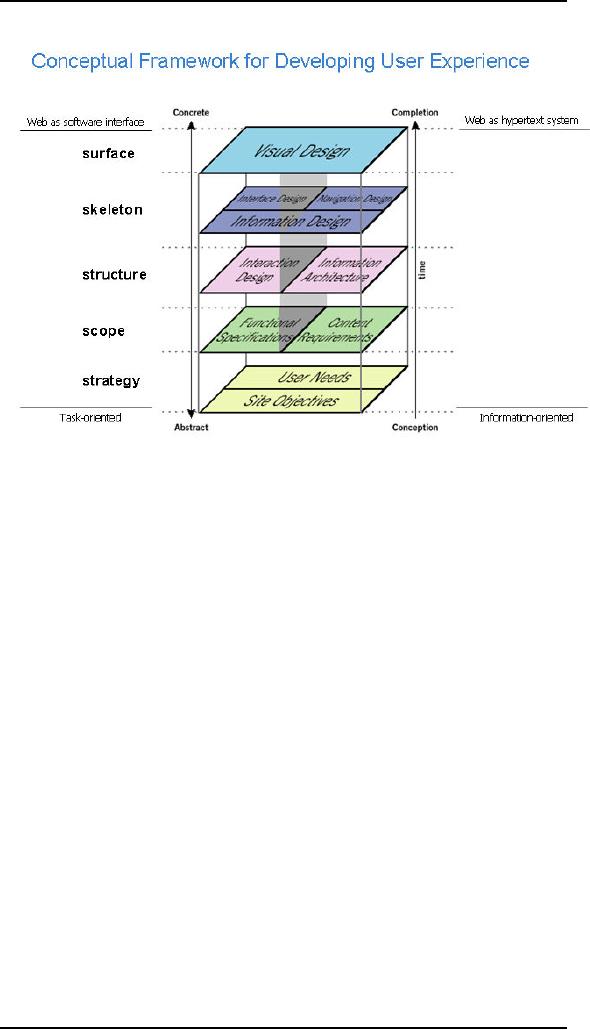 |
THE RELATIONSHIP BETWEEN EVALUATION AND USABILITY |
| << EVALUATION – PART VI |
| BEHAVIOR & FORM: UNDERSTANDING UNDO, TYPES AND VARIANTS, INCREMENTAL AND PROCEDURAL ACTIONS >> |

Human
Computer Interaction
(CS408)
VU
Lecture35
Lecture
35. Evaluation
Part VII
Learning
Goals
The
aim of this lecture is to
understand the strategic
nature of usability
�
The
aim of this lecture is to
understand the nature of the
Web
�
35.1
The relationship
between evaluation and usability?
With
the help of evaluation we
can uncover problems in the
interface that will help
to
improve
the usability of the
product.
Questions
to ask
� Do
you understand the
users?
� Do
you understand the
medium?
� Do
you understand the
technologies?
� Do
you have commitment?
Technologies
� You
must understand the constraints of
technology
� What
can we implement using
current technologies
� Building
a good system requires a
good understanding of
technology
constraints
and potentials
Users
Do you
know your users?
�
What
are their goals and
behaviors?
�
How
can they be
satisfied?
�
Use
goals and personas
�
Commitment
� Building
usable systems requires
commitment?
� Do
you have commitment at every
level in your
organization?
Medium
� You
must understand the medium
that you are working in to
build a good
usable
system
321

Human
Computer Interaction
(CS408)
VU
Nature of
the Web Medium
The
World Wide Web is a
combination of many different
mediums of
communication.
Print
(newspapers,
Audio
(radio, CDs,
Video
(TV, movies)
magazines,
books)
etc.)
Traditional
software
applications
It would
be true to say that the
Web is in fact a super
medium which incorporates
all
of the
above media.
Today's
we pages and applications
incorporate elements of the following
media:
� Print
� Video
� Audio
� Software
applications
Because
of its very diverse nature,
the Web is a unique medium
and presents many
challenges
for its designers.
We can
more clearly understand the
nature of the Web by looking
at a conceptual
framework.
322

Human
Computer Interaction
(CS408)
VU
The
Surface Plane
On the
surface you see a series of
Web pages, made up of images
and text. Some of
these
images are things you can
click on, performing some
sort of function such
as
taking
you to a shopping cart. Some
of these images are just illustrations,
such as a
photograph
of a book cover or the logo
of the site itself.
The
Skeleton Plane
Beneath
that surface is the skeleton of
the site: the placement of
buttons, tabs,
photos,
and
blocks of text. The skeleton
is designed to optimize the
arrangement of these
elements
for maximum effect and
efficiency-so that you remember
the logo and
can
find
that shopping cart button
when you need it.
The
Structure Plane
The
skeleton is a concrete expression of the
more abstract structure of the
site. The
skeleton
might define the placement
of the interface elements on our
checkout page;
the
structure would define how
users got to that page and
where they could go
when
they
were finished there. The
skeleton might define the
arrangement of navigational
items
allowing the users to browse
categories of books; the structure
would define
what
those categories actually were.
The Scope
Plane
The
structure defines the way in
which the various features
and functions of the
site
fit
together. Just what those
features and functions are
constitutes the scope of the
site.
Some
sites that sell books
offer a feature that enables
users to save previously
used
addresses
so they can be used again.
The question of whether that
feature-or any
feature-is
included on a site is a question of
scope.
323

Human
Computer Interaction
(CS408)
VU
The
Strategy Plane
The
scope is fundamentally determined by
the strategy of the site.
This strategy
incorporates
not only what the
people running the site
want to get out of it but
what
the
users want to get out of
the site as well. In the
case of our bookstore
example,
some of
the strategic objectives are
pretty obvious: Users want to
buy books, and we
want to
sell them. Other objectives
might not be so easy to
articulate.
Building
from Bottom to Top
These
five planes-strategy, scope,
structure, skeleton, and
surface�provide a
conceptual
framework for talking about
user experience problems and
the tools we
use to
solve them.
To
further complicate matters, people will
use the same terms in
dif�ferent ways. One
person
might use "information
design" to refer to what
another knows as
"information
architecture."
And what's the difference
between "interface design"
and "interaction
design?"
Is there one?
Fortunately,
the field of user experience
seems to be moving out of
this Babel-like
state.
Consistency is gradually creeping
into our dis�cussions of these
issues. To
understand
the terms themselves, how
ever, we should look at
where they came
from.
When
the Web started, it was just
about hypertext. People
could create documents,
and
they could link them to
other documents. Tim Berners-Lee,
the inventor of the
Web,
created it as a way for researchers in
the high-energy physics
community, who
were
spread out all over
the world, to share and
refer to each other's findings.
He
knew
the Web had the
potential to be much more
than that, but few
others really
understood
how great its potential
was.
People
originally seized on the Web
as a new publishing medium,
but as technology
advanced
and new features were
added to Web browsers and
Web servers alike,
the
Web
took on new capabilities.
After the Web began to catch on in
the larger Internet
community,
it developed a more complex
and robust feature set
that would enable
Web
sites not only to distribute
information but to collect
and manipulate it as
well.
With
this, the Web became
more interactive, responding to
the input of users in
ways
that
were very much like
traditional desktop
applications.
With
the advent of commercial interests on
the Web, this application
functionality
found a
wide range of uses, such as
electronic commerce, community forums,
and
online
banking, among others.
Meanwhile, the Web continued
to flourish as a
publishing
medium, with countless newspaper and
magazine sites augmenting
the
wave of
Web-only "e-zines" being
published. Technology continued to
advance on
both
fronts as all kinds of sites
made the transition from
static collections of
information
that changed infrequently to dynamic,
database-driven sites that
were
constantly
evolving.
When
the Web user experience
community started to form, its
members spoke two
different
languages. One group saw
every problem as an application
design problem,
and
applied problem-solving approaches from
the traditional desktop and
mainframe
software
worlds. (These, in turn, were
rooted in common practices applied to
creating
all
kinds of products, from cars
to running shoes.) The other
group saw the Web
in
terms of
information distribution and
retrieval, and applied
problem-solving
approaches
from the traditional worlds
of publishing, media, and
information science.
324

Human
Computer Interaction
(CS408)
VU
This
became quite a stumbling
block. Very little progress
could be made when
the
community
could not even agree on basic
terminology. The waters were
further
muddied
by the fact that many
Web sites could not be
neatly categorized as
either
applications
or hypertext information spaces-a
huge number seemed to be a
sort of
hybrid,
incorporating qualities from
each world.
To
address this basic duality
in the nature of the Web,
let's split our five planes
down
the
middle. On the left, we'll
put those elements specific to
using the Web as a
software
interface. On the right,
we'll put the elements
specific to hypertext
information
spaces.
On the
software side, we are mainly
concerned with tasks-the steps involved
in a
process
and how people think
about completing them. Here,
we consider the site as
a
tool or
set of tools that the
user employs to accomplish
one or more tasks. On
the
hypertext
side, our concern is information-what
information the site offers
and what it
means to
our users. Hypertext is
about creating an information
space that users
can
move
through.
The
Elements of User
Experience
Now we
can map that whole
confusing array of terms into
the model. By
breaking
each
plane down into its
component elements, we'll be able to
take a closer look at
how
all the pieces fit
together to create the whole
user experience.
The
Strategy Plane
The
same strategic concerns come
into play for both
software products and
information
spaces. User needs are
the goals for the
site that come from outside
our
organization-specifically
from the people who will
use our site. We must
understand
what
our audience wants from us
and how that fits in
with other goals it
has.
Balanced
against user needs are
our own objectives for
the site. These site
objectives
can be
business goals ("Make $1
million in sales over the
Web this year") or
other
kinds of
goals ("Inform voters about
the candidates in the next
election").
The Scope
Plane
On the
software side, the strategy
is translated into scope
through the creation
of
functional
specifications: a detailed description of
the "feature set" of the
product. On
the
information space side,
scope takes the form of
content requirements: a
description
of the various content elements
that will be
required.
The
Structure Plane
The
scope is given structure on
the software side through
interaction design, in
which
we define
how the system behaves in
response to the user. For
information spaces,
the
structure
is the information architecture:
the arrangement of content elements
within
the
information space.
The
Skeleton Plane
The
skeleton plane breaks down
into three components. On
both sides, we must
address
information design: the
presentation of information in a way
that facilitates
understanding.
For software products, the
skeleton also includes
interface design, or
arranging
interface elements to enable users to
interact with the
functionality of the
system.
The interface for an
information space is its
navigation design: the set
of
screen
elements that allow the user
to move through the
information architecture.
The
Surface Plane
Finally,
we have the surface. Regardless of
whether we are dealing with a
software
product
or an information space, our
concern here is the same:
the visual design, or
the
look of the finished
product.
325

Human
Computer Interaction
(CS408)
VU
Using
the Elements
Few
sites fall exclusively on
one side of this model or
the other. Within each
plane,
the
elements must work together to accomplish
that plane's goals. For
example,
information
design, navigation design,
and interface design jointly
define the skeleton
of a
site. The effects of
decisions you make about
one element from all
other elements
on the
plane is very difficult. All
the elements on every plane
have a common
Function-in
this example, defining the
site's skeleton-even if they
perform that
function
in different ways.elements on the
plane is very difficult. All
the elements on
every
plane have a common
function-in this example,
defining the site's
skeleton-even
if they
perform that function in
different ways.
This
model, divided up into neat
boxes and planes, is a convenient
way to think about
user
experience problems. In reality,
however, the lines between
these areas are not
so
clearly
drawn. Frequently, it can be
difficult to identify whether a
particular user
experience
problem is best solved
through attention to one
element instead of
another.
Can a
change to the visual design do
the trick, or will the
underlying navigation
design
have to be reworked? Some
problems require attention in
several areas at once,
and
some seem to straddle the
borders identified in this
model.
The
way organizations often
delegate responsibility for
user experience issues
only
complicates
matters further. In some organizations,
you will encounter people
with
job
titles like information
architect or interface designer.
Don't be confused by
this.
These
people generally have
expertise spanning many of
the elements of user
experience,
not just the specialty
indicated by their title.
It's not necessary for
thinking
about
each of these issues.
A couple
of additional factors go into
shaping the final user
experience that you
won't
find
covered in detail here. The
first of these is content.
The old saying (well,
old in
Web
years) is that "content is king" on
the Web. This is absolutely
true-the single
most
important thing most Web
sites can offer to their
users is content that those
users
will find
valuable.
326
Table of Contents:
- RIDDLES FOR THE INFORMATION AGE, ROLE OF HCI
- DEFINITION OF HCI, REASONS OF NON-BRIGHT ASPECTS, SOFTWARE APARTHEID
- AN INDUSTRY IN DENIAL, SUCCESS CRITERIA IN THE NEW ECONOMY
- GOALS & EVOLUTION OF HUMAN COMPUTER INTERACTION
- DISCIPLINE OF HUMAN COMPUTER INTERACTION
- COGNITIVE FRAMEWORKS: MODES OF COGNITION, HUMAN PROCESSOR MODEL, GOMS
- HUMAN INPUT-OUTPUT CHANNELS, VISUAL PERCEPTION
- COLOR THEORY, STEREOPSIS, READING, HEARING, TOUCH, MOVEMENT
- COGNITIVE PROCESS: ATTENTION, MEMORY, REVISED MEMORY MODEL
- COGNITIVE PROCESSES: LEARNING, READING, SPEAKING, LISTENING, PROBLEM SOLVING, PLANNING, REASONING, DECISION-MAKING
- THE PSYCHOLOGY OF ACTIONS: MENTAL MODEL, ERRORS
- DESIGN PRINCIPLES:
- THE COMPUTER: INPUT DEVICES, TEXT ENTRY DEVICES, POSITIONING, POINTING AND DRAWING
- INTERACTION: THE TERMS OF INTERACTION, DONALD NORMAN’S MODEL
- INTERACTION PARADIGMS: THE WIMP INTERFACES, INTERACTION PARADIGMS
- HCI PROCESS AND MODELS
- HCI PROCESS AND METHODOLOGIES: LIFECYCLE MODELS IN HCI
- GOAL-DIRECTED DESIGN METHODOLOGIES: A PROCESS OVERVIEW, TYPES OF USERS
- USER RESEARCH: TYPES OF QUALITATIVE RESEARCH, ETHNOGRAPHIC INTERVIEWS
- USER-CENTERED APPROACH, ETHNOGRAPHY FRAMEWORK
- USER RESEARCH IN DEPTH
- USER MODELING: PERSONAS, GOALS, CONSTRUCTING PERSONAS
- REQUIREMENTS: NARRATIVE AS A DESIGN TOOL, ENVISIONING SOLUTIONS WITH PERSONA-BASED DESIGN
- FRAMEWORK AND REFINEMENTS: DEFINING THE INTERACTION FRAMEWORK, PROTOTYPING
- DESIGN SYNTHESIS: INTERACTION DESIGN PRINCIPLES, PATTERNS, IMPERATIVES
- BEHAVIOR & FORM: SOFTWARE POSTURE, POSTURES FOR THE DESKTOP
- POSTURES FOR THE WEB, WEB PORTALS, POSTURES FOR OTHER PLATFORMS, FLOW AND TRANSPARENCY, ORCHESTRATION
- BEHAVIOR & FORM: ELIMINATING EXCISE, NAVIGATION AND INFLECTION
- EVALUATION PARADIGMS AND TECHNIQUES
- DECIDE: A FRAMEWORK TO GUIDE EVALUATION
- EVALUATION
- EVALUATION: SCENE FROM A MALL, WEB NAVIGATION
- EVALUATION: TRY THE TRUNK TEST
- EVALUATION – PART VI
- THE RELATIONSHIP BETWEEN EVALUATION AND USABILITY
- BEHAVIOR & FORM: UNDERSTANDING UNDO, TYPES AND VARIANTS, INCREMENTAL AND PROCEDURAL ACTIONS
- UNIFIED DOCUMENT MANAGEMENT, CREATING A MILESTONE COPY OF THE DOCUMENT
- DESIGNING LOOK AND FEEL, PRINCIPLES OF VISUAL INTERFACE DESIGN
- PRINCIPLES OF VISUAL INFORMATION DESIGN, USE OF TEXT AND COLOR IN VISUAL INTERFACES
- OBSERVING USER: WHAT AND WHEN HOW TO OBSERVE, DATA COLLECTION
- ASKING USERS: INTERVIEWS, QUESTIONNAIRES, WALKTHROUGHS
- COMMUNICATING USERS: ELIMINATING ERRORS, POSITIVE FEEDBACK, NOTIFYING AND CONFIRMING
- INFORMATION RETRIEVAL: AUDIBLE FEEDBACK, OTHER COMMUNICATION WITH USERS, IMPROVING DATA RETRIEVAL
- EMERGING PARADIGMS, ACCESSIBILITY
- WEARABLE COMPUTING, TANGIBLE BITS, ATTENTIVE ENVIRONMENTS